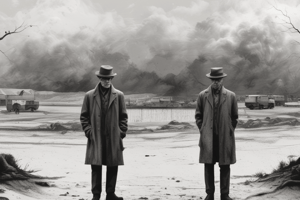Podcast
Questions and Answers
Who are the main characters who wait for Godot in the play?
Who are the main characters who wait for Godot in the play?
- Didi and Gogo
- Pozzo and Lucky
- Godot and Lucky
- Vladimir and Estragon (correct)
Which character in the play is a slave?
Which character in the play is a slave?
- Lucky (correct)
- Vladimir
- Pozzo
- Godot
What is a central theme in 'Waiting for Godot'?
What is a central theme in 'Waiting for Godot'?
- Happiness
- Faith
- Absurdity (correct)
- Success
What does the tree symbolize in the play?
What does the tree symbolize in the play?
What style is 'Waiting for Godot' written in?
What style is 'Waiting for Godot' written in?
Who appears to distract Vladimir and Estragon from their waiting?
Who appears to distract Vladimir and Estragon from their waiting?
What does the road symbolize in the play?
What does the road symbolize in the play?
What is a defining characteristic of the play's structure?
What is a defining characteristic of the play's structure?
Flashcards are hidden until you start studying
Study Notes
Overview
Waiting for Godot is a play written by Samuel Beckett, first performed in 1953.
Plot
- The play revolves around two characters, Vladimir and Estragon, who wait in vain for someone named Godot.
- The story is divided into two acts, each depicting a day in the lives of the two protagonists.
- The play's plot is minimal, with the characters engaging in conversations, arguing, and performing mundane tasks.
Characters
- Vladimir (Didi): The more rational and dominant of the two characters.
- Estragon (Gogo): The more impulsive and emotional of the two characters.
- Pozzo: A traveler who appears with his slave, Lucky, and provides a distraction from Vladimir and Estragon's waiting.
- Lucky: Pozzo's slave, who is mute and obedient.
- Godot: The mysterious figure whom Vladimir and Estragon wait for, but who never arrives.
Themes
- Absurdity: The play's central theme, highlighting the meaninglessness and uncertainty of human existence.
- Waiting: The futile act of waiting for something that may never arrive.
- Identity: The characters' search for self and purpose in a seemingly meaningless world.
- Relationships: The complex and dependent relationship between Vladimir and Estragon.
Style and Structure
- Absurdist theatre: The play's unconventional style, characterized by illogical events, repetition, and ambiguity.
- Cyclical structure: The play's two acts mirror each other, emphasizing the characters' stagnation and lack of progress.
Symbolism
- Godot: Often interpreted as God, death, or an unattainable goal.
- The tree: A symbol of life, death, and the cycle of existence.
- The road: Represents the characters' journey, or lack thereof, in life.
Impact and Legacy
- Influence on modern theatre: Waiting for Godot's absurdist style has influenced numerous playwrights and performances.
- Cultural significance: The play has become a cultural icon, symbolizing existential crises and the human condition.
Overview
- Waiting for Godot is a play written by Samuel Beckett, first performed in 1953.
Plot
- The play centers around Vladimir and Estragon waiting for Godot, who never arrives.
- The story is divided into two acts, each depicting a day in the lives of the two protagonists.
- The play's plot is minimalist, featuring conversations, arguments, and mundane tasks.
Characters
- Vladimir (Didi): The more rational and dominant of the two main characters.
- Estragon (Gogo): The more impulsive and emotional of the two main characters.
- Pozzo: A traveler who appears with his slave, Lucky, and provides a distraction.
- Lucky: Pozzo's mute and obedient slave.
- Godot: The mysterious figure whom Vladimir and Estragon wait for in vain.
Themes
- Absurdity: The play highlights the meaninglessness and uncertainty of human existence.
- Waiting: The futile act of waiting for something that may never arrive.
- Identity: The characters' search for self and purpose in a seemingly meaningless world.
- Relationships: The complex and dependent relationship between Vladimir and Estragon.
Style and Structure
- Absurdist theatre: The play's unconventional style characterized by illogical events, repetition, and ambiguity.
- Cyclical structure: The play's two acts mirror each other, emphasizing the characters' stagnation and lack of progress.
Symbolism
- Godot: Often interpreted as God, death, or an unattainable goal.
- The tree: A symbol of life, death, and the cycle of existence.
- The road: Represents the characters' journey, or lack thereof, in life.
Impact and Legacy
- Influence on modern theatre: Waiting for Godot's absurdist style has influenced numerous playwrights and performances.
- Cultural significance: The play has become a cultural icon, symbolizing existential crises and the human condition.
Studying That Suits You
Use AI to generate personalized quizzes and flashcards to suit your learning preferences.




